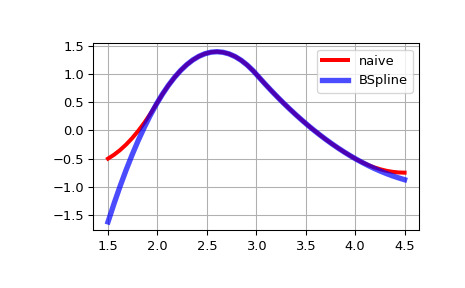本文简要介绍 python 语言中 scipy.interpolate.BSpline 的用法。
用法:
class scipy.interpolate.BSpline(t, c, k, extrapolate=True, axis=0)#B-spline 基础上的单变量样条。
其中是B-spline 度的基函数k和结t.
- t: ndarray, 形状 (n+k+1,)
结
- c: ndarray,形状(> = n,...)
样条系数
- k: int
B-spline度
- extrapolate: bool 或 ‘periodic’,可选
是推断超出基本区间
t[k] .. t[n]还是返回 nans。如果为 True,则外推在基本区间上活动的 b-spline 函数的第一个和最后一个多项式片段。如果‘periodic’,使用周期性外推。默认为真。- axis: 整数,可选
插值轴。默认为零。
参数 ::
注意:
B-spline 基本元素通过以下方式定义
实施细节
至少
k+1度样条曲线需要系数k, 以便n >= k+1.附加系数,c[j]和j > n, 被忽略。B-spline度的基本元素k形成统一的分区基本区间,
t[k] <= x <= t[n].
参考:
[1]Tom Lyche 和 Knut Morken,样条方法,http://www.uio.no/studier/emner/matnat/ifi/INF-MAT5340/v05/undervisningsmateriale/
[2]Carl de Boor,样条曲线实用指南,Springer,2001。
例子:
将 B-splines 的递归定义翻译成 Python 代码,我们有:
>>> def B(x, k, i, t): ... if k == 0: ... return 1.0 if t[i] <= x < t[i+1] else 0.0 ... if t[i+k] == t[i]: ... c1 = 0.0 ... else: ... c1 = (x - t[i])/(t[i+k] - t[i]) * B(x, k-1, i, t) ... if t[i+k+1] == t[i+1]: ... c2 = 0.0 ... else: ... c2 = (t[i+k+1] - x)/(t[i+k+1] - t[i+1]) * B(x, k-1, i+1, t) ... return c1 + c2>>> def bspline(x, t, c, k): ... n = len(t) - k - 1 ... assert (n >= k+1) and (len(c) >= n) ... return sum(c[i] * B(x, k, i, t) for i in range(n))请注意,这是评估B-splines 的一种低效(如果直接)的方法——这个样条线类以等效但更有效的方式执行它。
在这里,我们在基区间
2 <= x <= 4上构造一个二次样条函数,并与评估样条的朴素方法进行比较:>>> from scipy.interpolate import BSpline >>> k = 2 >>> t = [0, 1, 2, 3, 4, 5, 6] >>> c = [-1, 2, 0, -1] >>> spl = BSpline(t, c, k) >>> spl(2.5) array(1.375) >>> bspline(2.5, t, c, k) 1.375请注意,基准区间之外的结果有所不同。这是因为
BSpline推断出在基本区间上活动的 B-spline 函数的第一个和最后一个多项式。>>> import matplotlib.pyplot as plt >>> import numpy as np >>> fig, ax = plt.subplots() >>> xx = np.linspace(1.5, 4.5, 50) >>> ax.plot(xx, [bspline(x, t, c ,k) for x in xx], 'r-', lw=3, label='naive') >>> ax.plot(xx, spl(xx), 'b-', lw=4, alpha=0.7, label='BSpline') >>> ax.grid(True) >>> ax.legend(loc='best') >>> plt.show()
- t: ndarray
结矢量
- c: ndarray
样条系数
- k: int
样条度
- extrapolate: bool
如果为 True,则外推在基本区间上活动的 b-spline 函数的第一个和最后一个多项式片段。
- axis: int
插值轴。
tck元组等效于
(self.t, self.c, self.k)(只读)。
属性 ::
相关用法
- Python SciPy interpolate.BPoly用法及代码示例
- Python SciPy interpolate.BarycentricInterpolator用法及代码示例
- Python SciPy interpolate.make_interp_spline用法及代码示例
- Python SciPy interpolate.krogh_interpolate用法及代码示例
- Python SciPy interpolate.InterpolatedUnivariateSpline用法及代码示例
- Python SciPy interpolate.LSQSphereBivariateSpline用法及代码示例
- Python SciPy interpolate.griddata用法及代码示例
- Python SciPy interpolate.splder用法及代码示例
- Python SciPy interpolate.LinearNDInterpolator用法及代码示例
- Python SciPy interpolate.PPoly用法及代码示例
- Python SciPy interpolate.NdBSpline用法及代码示例
- Python SciPy interpolate.pade用法及代码示例
- Python SciPy interpolate.barycentric_interpolate用法及代码示例
- Python SciPy interpolate.RegularGridInterpolator用法及代码示例
- Python SciPy interpolate.NdPPoly用法及代码示例
- Python SciPy interpolate.interp2d用法及代码示例
- Python SciPy interpolate.approximate_taylor_polynomial用法及代码示例
- Python SciPy interpolate.RectSphereBivariateSpline用法及代码示例
- Python SciPy interpolate.sproot用法及代码示例
- Python SciPy interpolate.splantider用法及代码示例
- Python SciPy interpolate.CloughTocher2DInterpolator用法及代码示例
- Python SciPy interpolate.interp1d用法及代码示例
- Python SciPy interpolate.splrep用法及代码示例
- Python SciPy interpolate.make_smoothing_spline用法及代码示例
- Python SciPy interpolate.Rbf用法及代码示例
注:本文由纯净天空筛选整理自scipy.org大神的英文原创作品 scipy.interpolate.BSpline。非经特殊声明,原始代码版权归原作者所有,本译文未经允许或授权,请勿转载或复制。
